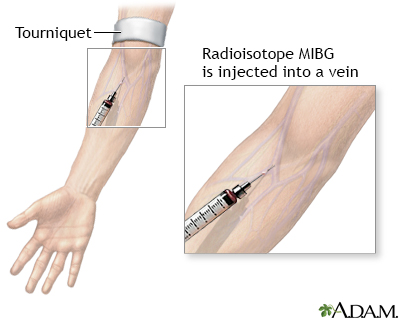MIBG scintiscan
Adrenal medullary imaging; Meta-iodobenzylguanidine scintiscan; Pheochromocytoma - MIBG; Neuroblastoma - MIBG; Carcinoid MIBG
An MIBG scintiscan is a type of imaging test. It uses a radioactive substance called a tracer injected into your body. A subsequent scan can find or confirm the presence of pheochromocytoma and neuroblastoma. These are types of tumors that affect nerve tissue.
Images

How the Test is Performed
A radioisotope (MIBG, iodine-131-meta-iodobenzylguanidine, or iodine-123-meta-iodobenzylguanidine) is injected into a vein. This compound attaches to specific tumor cells.
You will have the scan later that day or the next day. For this part of the test, you lie on a table under the arm of the scanner. Your abdomen is scanned. You may need to return for repeated scans for 1 to 3 days. Each scan takes 1 to 2 hours.
Before or during the test, you may be given an iodine mixture. This prevents your thyroid gland from absorbing too much of the radioactive substance.
How to Prepare for the Test
You will need to sign an informed consent form. You will be asked to wear a hospital gown or loose-fitting clothes. You will need to remove jewelry or metal objects before each scan. Many drugs interfere with the test. Ask your health care provider which of your regular medicines you may need to stop taking before the test.
How the Test will Feel
You will feel a sharp needle prick when the material is injected. The table may be cold or hard. You must lie still during the scan.
Why the Test is Performed
This test is done to help diagnose pheochromocytoma. It is done when an abdominal CT scan or an abdominal MRI scan does not give a definite answer. It is also used to help diagnose neuroblastoma and can be used for carcinoid tumors.
Normal Results
There are no signs of a tumor.
What Abnormal Results Mean
Abnormal results may indicate:
- Pheochromocytoma
- Multiple endocrine neoplasia (MEN) II
- Carcinoid tumor
- Neuroblastoma
Risks
There is some exposure to radiation from the radioisotope. The radiation from this radioisotope is higher than from many others. You may need to take extra precautions for a few days after the test. Your provider will tell you what actions to take.
Before or during the test, you may be given an iodine solution. This will keep your thyroid gland from absorbing too much iodine. Usually people take potassium iodide for 1 day prior and 6 days after. This blocks the thyroid from taking up the MIBG.
This test should not be done on pregnant women. The radiation can pose danger to the unborn baby.
Related Information
PET scanPheochromocytoma
Tumor
CT scan
Multiple endocrine neoplasia (MEN) II
References
Cohen DL, Fishbein L. Secondary hypertension: pheochromocytoma and paraganglioma. In: Bakris GL, Sorrentino MJ, Laffin LJ, eds. Hypertension: A Companion to Braunwald's Heart Disease. 4th ed. Philadelphia, PA: Elsevier; 2024:chap 15.
Kutikov A, Crispen PL, Uzzo PG. Pathophysiology, evaluation, and medical management of adrenal disorders. In: Partin AW, Dmochowski RR, Kavoussi LR, Peters CA, eds. Campbell-Walsh-Wein Urology. 12th ed. Philadelphia, PA: Elsevier; 2021:chap 106.
Yeh MW, Livhits MJ, Duh Q-Y. The adrenal glands. In: Townsend CM Jr, Beauchamp RD, Evers BM, Mattox KL, eds. Sabiston Textbook of Surgery. 21st ed. Philadelphia, PA: Elsevier; 2022:chap 40.
BACK TO TOPReview Date: 7/15/2024
Reviewed By: Jason Levy, MD, FSIR, Northside Radiology Associates, Atlanta, GA. Also reviewed by David C. Dugdale, MD, Medical Director, Brenda Conaway, Editorial Director, and the A.D.A.M. Editorial team.

Health Content Provider
06/01/2025
|
A.D.A.M., Inc. is accredited by URAC, for Health Content Provider (www.urac.org). URAC's accreditation program is an independent audit to verify that A.D.A.M. follows rigorous standards of quality and accountability. A.D.A.M. is among the first to achieve this important distinction for online health information and services. Learn more about A.D.A.M.'s editorial policy, editorial process and privacy policy. A.D.A.M. is also a founding member of Hi-Ethics. This site complied with the HONcode standard for trustworthy health information from 1995 to 2022, after which HON (Health On the Net, a not-for-profit organization that promoted transparent and reliable health information online) was discontinued. |
The information provided herein should not be used during any medical emergency or for the diagnosis or treatment of any medical condition. A licensed medical professional should be consulted for diagnosis and treatment of any and all medical conditions. Links to other sites are provided for information only -- they do not constitute endorsements of those other sites. © 1997- 2025 A.D.A.M., a business unit of Ebix, Inc. Any duplication or distribution of the information contained herein is strictly prohibited.
